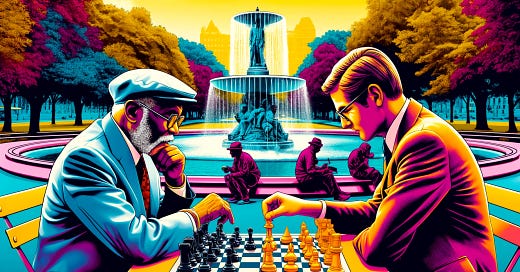The Power of Community Parks
A new report from the Trust for Public Land says parks can strengthen community and improve social cohesion
America is lonely, polarized and racially segregated. It’s got deep divisions and declining social capital—the networks of relationships among people who live and work in a particular society, enabling that society to function effectively.
Here’s what we know:
The latest Healthy Minds Monthly Poll from the American Psychiatric Association (APA) finds that, early in 2024, 30% of adults say they have experienced feelings of loneliness at least once a week over the past year, while 10% say they are lonely every day.
In the 2022 mid-term election, three out of 10 Americans said political polarization was the nation's top issue. Around two-thirds of both Democrats and Republicans believe members of the other party are dishonest and only 20% of marriages are politically mixed.
Research developed by the University of California at Berkeley in 2021 showed that racial residential segregation is both more widespread than is generally appreciated and more harmful. Their report found that more than 80% of major metropolitan areas in the United States were more segregated in 2019 than in 1990.
Despite these challenges, a new special report from the Trust for Public Land (TPL), The Power of Parks to Strengthen Community, finds that public parks are one way in which the United States can mend its frayed social fabric. By investing in parks and activating them with culturally relevant programs, it suggests that communities can overcome divisions and build a healthier, more cohesive society.
Parks as Catalysts for Community Cohesion
Parks stand out as unique public spaces that can bridge divides. They’re “third spaces,” outside of home and work, where individuals from diverse socio-economic backgrounds connect with others, known and unknown, over a shared interest or activity.
Included in the report are findings from TPL's analysis of park systems across the 100 most populous U.S. cities, known as the ParkScore. This index evaluates park systems based on access, equity, acreage, investment, and amenities. Additionally, TPL surveyed public and private organizations managing parks in these cities to understand their strategies for fostering social connections.
It reveals that cities with the highest ParkScore rankings exhibit stronger social connections among residents. In these cities, there are 26% more social connections between low- and high-income individuals and a 60% higher likelihood of volunteering than in cities with lower-ranking park systems.
Here are the top 10:
Washington, D.C.
Minneapolis, MN
St. Paul, MN
Irvine, CA
Arlington, VA
Seattle, WA
San Francisco, CA
Cincinnati, OH
Portland, WA
Chicago, IL
Best Practices
The report identifies four key strategies for leveraging parks to build community:
Developing Civic Infrastructure: Parks serve as civic spaces for voter registration, public protests, and community organizing. For instance, Raleigh's Department of Parks, Recreation, and Cultural Resources hosted a FIFA Women's World Cup watch party.
Investing in Community Engagement and Organizing: Effective park agencies avoid top-down approaches, instead involving residents in park planning and programming. Baltimore City Recreation and Parks exemplifies this by including community members in every stage of park development, from design charrettes to policy discussions.
Activating Bespoke Park Programs: Parks are most effective when they reflect their communities' unique cultures and interests. Through its Global Gatherings program, Tulsa's Gathering Place Park brings together diverse groups to celebrate cultural traditions, fostering a sense of belonging and mutual respect.
Building Strategic Partnerships: Collaborations with organizations across various sectors, including arts, public health, and education, amplify the impact of parks. San Francisco's India Basin Waterfront Park, developed with extensive community input and partnerships, aims to strengthen the neighborhood both socially and economically.
Continued Advocacy and Investment Needed for Change
The report concludes with a call to action for all stakeholders—local governments, nonprofits, philanthropies, and private citizens—to invest in parks and their programming. It emphasizes the need for parks departments to engage residents at every phase, from initial planning to ongoing stewardship. The significant public and private spending on parks in recent years underscores the potential for these green spaces to foster community cohesion.
“Park leaders are stepping up to promote community connection and address the national epidemic of loneliness and social isolation,” says Diane Regas, President and CEO of Trust for Public Land. “By mixing tried and true strategies like fitness classes and sports leagues with innovative ideas like intergenerational storytime, where senior volunteers share their favorite books with children, cities are finding creative ways to bring people together and strengthen community bonds.”
At the federal level, the Outdoors for All Act (O4A) is highlighted as a critical piece of legislation that would secure funding for parks in underserved communities, ensuring broader access to their benefits. On April 9, it unanimously passed the U.S. House of Representatives as a part of the Expanding Public Lands Outdoor Recreation Experiences (EXPLORE) Act.
“By passing the Outdoors for All Act, we make it crystal clear that funding for urban parks is here to stay,” noted bill sponsor Representative Nanette Diaz Barragán (D-CA). “Far too many low-income communities like the one I grew up in lack access to a nearby green space.”





